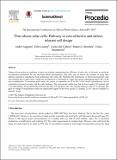Thin silicon solar cells: Pathway to cost-effective and defect-tolerant cell design
Author(s)
Augusto, André; Bowden, Stuart G.; Looney, Erin Elizabeth; del Canizo Nadal, Carlos; Buonassisi, Anthony
Download1-s2.0-S1876610217343175-main.pdf (1.108Mb)
PUBLISHER_CC
Publisher with Creative Commons License
Creative Commons Attribution
Terms of use
Metadata
Show full item recordAbstract
Thinner silicon wafers are a pathway to lower cost without compromising the efficiency of solar cells. In this work, we study the recombination mechanism for thin and thick silicon heterojunction solar cells, and we discuss the potential of using more defective material to manufacture high performance thin solar cells. Modelling the performance of silicon heterojunction solar cells indicates that at open-circuit voltage the recombination is dominated by Auger and surface, representing nearly 90% of the total recombination. At maximum power point, the surface is responsible for 50 to 80% of the overall recombination, and its contribution increases inversely with the wafer thickness. The expe rimental results show that for lower quality CZ material with 1 ms bulk lifetime, 60 μm-thick cells perform better than 170 μm-thick cells. The potential efficiency gain is 1% absolute. The gains in voltage of using thinner wafers are significantly higher for the lower quality CZ material, 25 mV, than for standard CZ material,10 mV.
Date issued
2017-09Department
Massachusetts Institute of Technology. Department of Mechanical EngineeringJournal
Energy Procedia
Publisher
Elsevier BV
Citation
Augusto, André, Erin Looney, Carlos del Cañizo, Stuart G. Bowden, and Tonio Buonassisi. “Thin Silicon Solar Cells: Pathway to Cost-Effective and Defect-Tolerant Cell Design.” Energy Procedia 124 (September 2017): 706–711.
Version: Final published version
ISSN
18766102